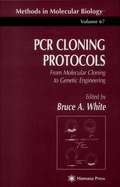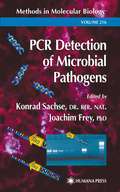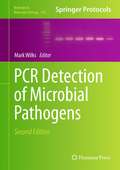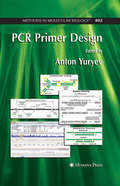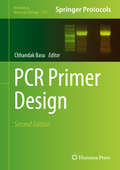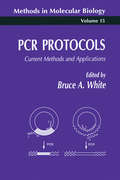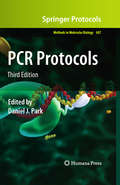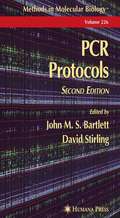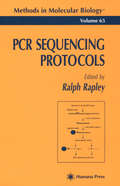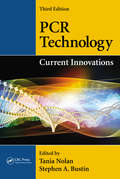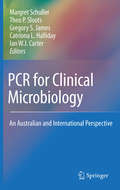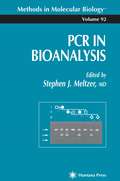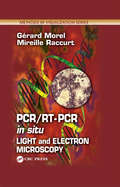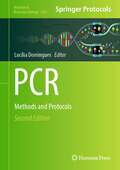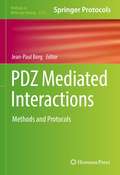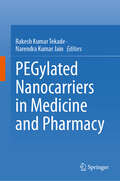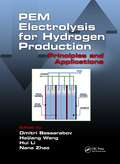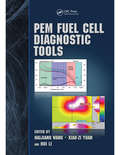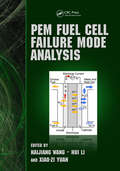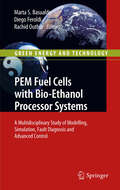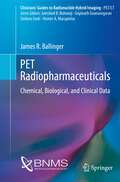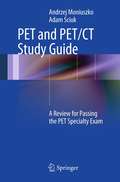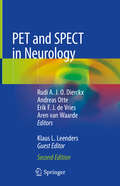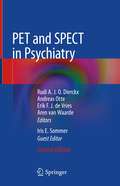- Table View
- List View
PCR Cloning Protocols
by Bruce A. WhiteDistinguished scientists and researchers present a comprehensive collection of current preparative PCR techniques that can be used in cloning and modifying DNA and cDNA. Topics include performing and optimizing PCR (including long PCR), cloning PCR products, cloning unknown neighboring DNA, and library construction and screening. Also covered are mutagenesis, recombination, and in vitro selection, differential and subtractive approaches to cDNA analysis and screening, and cloning members of gene families. The techniques bring to both new and established researchers the power to apply PCR-based methodology to the cloning and modification of DNA, either through innovative protocols or by fostering individual creativity to modify and customize the protocols to best fit their own needs.
PCR Detection of Microbial Pathogens
by Konrad Sachse Joachim FreyHands-on laboratory experts present a set of "classic" PCR-based methods for the identification and detection of important animal and food microbial pathogens, including several zoonotic agents. These proven techniques can be precisely applied to a wide variety of microbes, among them Campylobacter spp., chlamydiae, toxigenic clostridia, Escherichia coli (STEC), Listeria monocytogenes, mycoplasmas, salmonellae, and Yersinia enterocolitica. Additional chapters review the specificity and performance of diagnostic PCR analysis, the pre-PCR processing of samples, the critical aspects of standardizing PCR methods, and the general issues involved in using PCR technology for microbial diagnosis.
PCR Detection of Microbial Pathogens
by Mark WilksPCR methods for the detection of microbial pathogens have made relatively little impact in diagnostic microbiology laboratories due to the common decision to use expensive commercially produced tests rather than the cheaper alternative of developing one's own tests or introducing tests developed by other workers. PCR Detection of Microbial Pathogens, Second Edition presents alternatives to commercially produced PCR methods to detect microbial pathogens. Although most of the chapters in this book are devoted to the detection of specific pathogens, the first chapters in this book should appeal to anyone working in this field regardless of their particular interests. Although PCR tests can often be made to work with relatively little effort, it is often unclear how efficient the PCR test is, how inhibitory the specimen containing the pathogen of interest is and how the test can be quality controlled. All of which are of great importance in developing tests for diagnostic use. These topics are covered in great depth at the beginning of the book. The main part of the book is devoted to describing methods for the detection of a wide range of pathogens and from widely different specimens and situations. Written in the highly successful Methods in Molecular BiologyTM series format, chapters contain introductions to their respective topics, lists of the necessary materials and reagents, step-by-step, readily reproducible laboratory protocols, and notes on troubleshooting and avoiding known pitfalls. Authoritative and accessible, PCR Detection of Microbial Pathogens, Second Edition serves microbiologists regardless of their particular interest because, when used together with the general principles, the sheer variety of procedures provided here enables the reader to design and introduce diagnostic tests in the laboratory with confidence.
PCR Primer Design
by Anton YuryevAt the heart of most high-throughput methods is the technique of polymerase chain reaction (PCR). This book focuses on primer design, which is critical to both the efficiency and the accuracy of the PCR. With intricate descriptions of basic approaches as well as specialized methods, "PCR Primer Design" is an exceptional reference for all those involved in studying the genome.
PCR Primer Design
by Chhandak BasuThis volume provides an overview on design PCR primers for successful DNA amplification. Chapters focus on primer design strategies for quantitative PCR, in silico PCR primer design, and primer design using software. Written in the highly successful Methods in Molecular Biology series format, chapters include introductions to their respective topics, lists of the necessary materials and reagents, step-by-step, readily reproducible laboratory protocols, and tips on troubleshooting and avoiding known pitfalls. Authoritative and easily accessible, PCR Primer Design, Second Edition seeks to aid molecular biology students, researchers, professors and PCR enthusiasts.
PCR Protocols
by Bruce A. WhiteThe newest and most up-to-date collection, PCR Protocols offers detailed laboratory procedures for the use of polymerase chain reactions in a wide range of applications. Although specific examples and experimental systems are described, the book's focus is on general applications that can be modified to suit a broad spectrum of research systems, thus making its scope appealing to nearly all researchers. PCR Protocols features clear, easy-to-follow descriptions of procedures and a Notes section in each chapter to provide tips, alternative suggestions, and other enhancements of the protocols. Key Topics and Techniques: basic startup procedures for PCR * PCR in detecting DNA and RNA * PCR in DNA synthesis and mutagenesis * PCR cloning of DNA * selection of primers * radioactive and nonradioactive labeling * quantitation of PCR products by HPLC * chromosome assignment * PCR mapping of HLA genes * sequencing of PCR products * genomic footprinting * quantitation of tumor gene expression * screening of phage libraries * SSP-PCR and genome walking * subcloning of PCR products.
PCR Protocols
by Daniel J. ParkKnown for flexibility and robustness, PCR techniques continue to improve through numerous developments, including the identification of thermostable DNA polymerases which exhibit a range of properties to suit given applications. PCR Protocols, Third Edition selects recently developed tools and tricks, contributed by field-leading authors, for the significant value that they add to more generally established methods. Along with the cutting-edge methodologies, this volume describes many core applications, such as PCR cloning and sequencing, expression, copy number or methylation profile analysis, 'DNA fingerprinting', diagnostics, protein engineering, interaction screening as well as a chapter highlighting workflow considerations and contamination control, crucial for all PCR methods. Written in the highly successful Methods in Molecular BiologyTM series format, chapters include introductions to their respective topics, lists of the necessary reagents and materials, step-by-step, readily reproducible laboratory protocols, and tips on troubleshooting and avoiding known pitfalls. Authoritative and up-to-date, PCR Protocols, Third Edition seeks to further elucidate this essential technique while also providing core principles with broad applications for scientists of all backgrounds.
PCR Protocols
by John M. Bartlett David StirlingIn this new edition, the editors have thoroughly updated and dramatically expanded the number of protocols to take advantage of the newest technologies used in all branches of research and clinical medicine today. These proven methods include real time PCR, SNP analysis, nested PCR, direct PCR, and long range PCR. Among the highlights are chapters on genome profiling by SAGE, differential display and chip technologies, the amplification of whole genome DNA by random degenerate oligonucleotide PCR, and the refinement of PCR methods for the analysis of fragmented DNA from fixed tissues. Each fully tested protocol is described in step-by-step detail by an established expert in the field and includes a background introduction outlining the principle behind the technique, equipment and reagent lists, tips on trouble shooting and avoiding known pitfalls, and, where needed, a discussion of the interpretation and use of results.
PCR Protocols in Molecular Toxicology (Methods in Life Sciences - Toxicology Section)
by John P. Vanden HeuvelMolecular toxicology is an emerging discipline that utilizes molecular and cell biology to understand how drugs and chemicals result in their unwanted effects. PCR Protocols in Molecular Toxicology is a practical guide to the use of polymerase chain reaction (PCR) to help examine, on a molecular and cellular level, how toxic responses are manifested. It offers a basic understanding of PCR and its optimization, as well as describing specific, high-impact areas of molecular toxicology and recent advances. The following techniques are described in detail: Quantitative reverse transcriptase PCR and methods to examine gene expression Differential display cloning Cloning and library screening by PCR Genotype and polymorphism analysis of drug and toxicant metabolizing enzymes Basic, non-PCR based molecular biology methods PCR Protocols in Molecular Toxicology will aid both novices and experienced PCR practitioners in using PCR to its fullest potential.
PCR Sequencing Protocols
by Ralph RapleyA superb, comprehensive collection of the most reliable protocols for PCR sequencing-all developed and described by eminent researchers and scientists who use them successfully every day. These protocols deal practically with those problems accompanying the rapid reassociation of amplified complementary strands by showing how sequencing reactions may be effectively modified, as well as complex methods of primer manipulation that enable the affinity purification, or its transcript production, of homogeneous single strands. They also provide all the necessary details of PCR purification, primer labeling, the preparation of sequencing gels, as well as of conventional methods for cloning PCR products into vectors and their subsequent sequencing.
PCR Technology: Current Innovations, Third Edition
by Stephen A. Bustin Tania NolanPCR's simplicity as a molecular technique is, in some ways, responsible for the huge amount of innovation that surrounds it, as researchers continually think of new ways to tweak, adapt, and re-formulate concepts and applications. PCR Technology: Current Innovations, Third Edition is a collection of novel methods, insights, and points of view that
PCR for Clinical Microbiology
by Catriona L. Halliday Ian W.J. Carter Gregory S. James Margret Schuller Theo P. SlootsNot another textbook, but a valuable tool for doctors and microbiologists wanting to know how to set up a PCR diagnostic microbiology laboratory according to current regulatory standards and perform assays supplied with patient clinical diagnostic criteria and easy to follow protocols. Whether laboratories are using commercial kits or in-house methods developed in their own laboratories or adopted from published methods, all clinical microbiology laboratories need to be able to understand, critically evaluate, perform and interpret these tests according to rigorous and clinically appropriate standards and international guidelines. The cost and effort of development and evaluation of in-house tests is considerable and many laboratories do not have the resources to do so. This compendium is a vehicle to improve and maintain the clinical relevance and high quality of diagnostic PCR. It is a unique collection of; guidelines for PCR laboratory set up and quality control, test selection criteria, methods and detailed step by step protocols for a diagnostic assays in the field of molecular microbiology. The structure of the book provides the PCR fundamentals and describes the clinical aspects and diagnosis of infectious disease. This is followed by protocols divided into; bacteria, virus, fungi and parasites, and susceptibility screens. The inclusion of medical criteria and interpretation adds value to the compendium and benefits clinicians, scientists, researchers and students of clinical diagnostic microbiology
PCR in Bioanalysis
by Stephen J MeltzerPCR in Bioanalysis offers powerful PCR-based protocols and assays in actual use or potential use in clinical medicine and commercial biology. The main focus of the book is on the commercial applications of PCR, as opposed to basic research uses. Topics covered include the measurement of hormone levels using PCR, transcription factor isolation, detection of viruses using PCR, detection of tumor contamination of stem cells, evaluation of grafts for tumor cells, and more.
PCR/RT- PCR in situ: Light and Electron Microscopy (Methods in Visualization)
by Gerard Morel Mireille RaccurtAlthough the polymerase chain reaction has revolutionized genetic analysis by amplifying rare nucleic acid sequences, the in situ application is the only method that allows the localization of amplified signal within tissue structure. The applications of in situ polymerase chain reaction have greatly enhanced the field of investigation in many disc
PCR: Methods and Protocols (Methods in Molecular Biology #2967)
by Lucília DominguesThis second volume focuses on PCR methods and PCR application specificities to the biotechnology and bioengineering field. New and updated chapters detail real-time PCR protocols, synthetic biology applications, pathogen detection, microfluidics, digital, multiplex detection recent advances. Written in the highly successful Methods in Molecular Biology series format, chapters include introductions to their respective topics, lists of the necessary materials and reagents, step-by-step, readily reproducible laboratory protocols, and key tips on troubleshooting and avoiding known pitfalls. Authoritative and cutting-edge, PCR: Methods and Protocols, Second Edition aims to be a useful and practical guide to new researchers and experts looking to expand their knowledge.
PDZ Mediated Interactions: Methods and Protocols (Methods in Molecular Biology #2256)
by Jean-Paul BorgThis volume provides readers with a comprehensive look at the latest techniques used to identify and characterize PDZ-mediated interactions. Chapters cover topics such as promiscuity, multimodularity, regulation, and viral recognition by PDZ domains. Written in the highly successful Methods in Molecular Biology series format, chapters include introductions to their respective topics, lists of the necessary materials and reagents, step-by-step, readily reproducible laboratory protocols, and tips on troubleshooting and avoiding known pitfalls.Cutting-edge and thorough, PDZ Mediated Interactions: Methods and Protocols is a valuable resource for all researchers interested in learning more about this developing field.
PEGylated Nanocarriers in Medicine and Pharmacy
by Rakesh Kumar Tekade Narendra Kumar JainThis book shelters the central principles, cutting-edge methodologies, and incipient thought processes applied to PEGylation research. The content also expounds on the critical properties of PEG and other polymers that can be applied to formulate a prolonged-circulating nanocarrier system for the delivery of gene, nucleic acid, drugs, protein, and peptide and diagnostic agents. The book summarizes the methodologies and effects of PEGylation on drug delivery and highlights recent developments in PEGylated drugs. It also aims to present vital biopharmaceutical fates of PEGylated therapeutics and examines the approaches involved in the preparation, physicochemical properties, and biological applications of long-circulating PEGylated pharmaceutical nanocarriers. This book also cross-talks and offers expert viewpoints on mucus-penetrating PEGylated nanocarrier, reversible PEGylation of nanocarriers, and Bio-PEGylation as well as PEGylation and its alternatives. The book also deals with hottopics including the current status and regulatory aspects of PEGylated Nanoproducts, and medicinal and pharmaceutical applications of PEGylated Nanocarriers. The book provides a comprehensive literature resource for the students, biologists, chemists, toxicologists, medical researchers, scientists in industries, research institutes, universities, and consultants involved in the development and testing of new advanced medicines
PEM Electrolysis for Hydrogen Production: Principles and Applications
by Hui Li Dmitri Bessarabov Haijiang Wang Nana ZhaoAn ever-increasing dependence on green energy has brought on a renewed interest in polymer electrolyte membrane (PEM) electrolysis as a viable solution for hydrogen production. While alkaline water electrolyzers have been used in the production of hydrogen for many years, there are certain advantages associated with PEM electrolysis and its relevan
PEM Fuel Cell Diagnostic Tools
by Hui Li Haijiang Wang Xiao-Zi YuanPEM Fuel Cell Diagnostic Tools presents various tools for diagnosing PEM fuel cells and stacks, including in situ and ex situ diagnostic tools, electrochemical techniques, and physical/chemical methods. The text outlines the principles, experimental implementation, data processing, and application of each technique, along with its capabilities and
PEM Fuel Cell Failure Mode Analysis
by Hui Li Haijiang Wang Xiao-Zi YuanPEM Fuel Cell Failure Mode Analysis presents a systematic analysis of PEM fuel cell durability and failure modes. It provides readers with a fundamental understanding of insufficient fuel cell durability, identification of failure modes and failure mechanisms of PEM fuel cells, fuel cell component degradation testing, and mitigation strategies agai
PEM Fuel Cells with Bio-Ethanol Processor Systems
by Rachid Outbib Diego Feroldi Marta S. BasualdoAn apparently appropriate control scheme for PEM fuel cells may actually lead to an inoperable plant when it is connected to other unit operations in a process with recycle streams and energy integration. PEM Fuel Cells with Bio-Ethanol Processor Systems presents a control system design that provides basic regulation of the hydrogen production process with PEM fuel cells. It then goes on to construct a fault diagnosis system to improve plant safety above this control structure. PEM Fuel Cells with Bio-Ethanol Processor Systems is divided into two parts: the first covers fuel cells and the second discusses plants for hydrogen production from bio-ethanol to feed PEM fuel cells. Both parts give detailed analyses of modeling, simulation, advanced control, and fault diagnosis. They give an extensive, in-depth discussion of the problems that can occur in fuel cell systems and propose a way to control these systems through advanced control algorithms. A significant part of the book is also given over to computer-aided engineering software tools that can be used to evaluate the dynamic performance of the overall plant. PEM Fuel Cells with Bio-Ethanol Processor Systems is intended for use by researchers and advanced students on chemical, electrical-electronic and mechanical engineering courses in which dynamics and control are incorporated with the traditional steady-state coverage of flowsheet synthesis, engineering economics and optimization.
PET Radiopharmaceuticals: Chemical, Biological, and Clinical Data (Clinicians’ Guides to Radionuclide Hybrid Imaging)
by James R. BallingerThis book presents in a consistent format data on ~50 PET radiopharmaceuticals in clinical use. Parameters include basic chemical data, normal biodistribution and excretion, activity administered, radiation dosimetry, patient preparation, and clinical utility, together with a few key references. In some cases a representative image is presented. The organisation is first by clinical specialty (oncology, cardiology, neurology) and within each section by radionuclide (F-18, C-11, etc). This book will be of interest mostly to nuclear medicine physicians and trainees, but also to a wider medical community including radiologists, oncologists and radiotherapists.
PET and PET/CT Study Guide
by Andrzej Moniuszko Adam SciukThe PET and PET/CT Study Guide presents a comprehensive review of nuclear medicine principles and concepts necessary for passing PET specialty board examinations. The practice questions and content are similar to those found on the Nuclear Medicine Technology Certification Board (NMTCB) exam, allowing test takers to maximize their chances of success. The book is organized by test sections of increasing difficulty, with over 650 multiple-choice questions covering all areas of positron emission tomography, including radiation safety; radionuclides; instrumentation and quality control; patient care; and diagnostic and therapeutic procedures. Detailed answers and explanations to the practice questions follow. Supplementary appendices include common formulas, numbers, and abbreviations, along with a glossary of terms for easy access by readers. The PET and PET/CT Study Guide is a valuable reference for nuclear medicine technologists, nuclear medicine physicians, and all other imaging professionals in need of a concise review of the basics of PET and PET/CT imaging.
PET and SPECT in Neurology
by Andreas Otte Erik F. J. de Vries Rudi A. J. O. Dierckx Klaus L. Leenders Aren Van WaardeThis book provides a comprehensive overview of the use of PET and SPECT in not only classic neurodegenerative disorders but also cerebrovascular disorders, brain tumors, epilepsy, head trauma, coma, sleeping disorders, and inflammatory and infectious diseases of the CNS. The new edition has been revised and updated to reflect recent advances and includes additional chapters, for example on the use of artificial intelligence and machine learning in imaging data analysis, the study of brain connectivity using PET and SPECT images, and the role of PET imaging in modulation of brain functioning by deep brain stimulation. The authors are renowned experts whose dedication to the investigation of neurological disorders through nuclear medicine technology has achieved international recognition. Most chapters are written jointly by a clinical neurologist and a nuclear medicine specialist to ensure a multidisciplinary approach. This state of the art compendium will be invaluable for neurologists and radiologists/nuclear medicine specialists and will also be informative for interested general practitioners and geriatricians. Companion volumes on PET and SPECT in psychiatry and in neurobiological systems complete a trilogy.
PET and SPECT in Psychiatry
by Andreas Otte Erik F. J. de Vries Rudi A. J. O. Dierckx Aren Van Waarde Iris E. SommerThis book provides a comprehensive overview of the use of PET and SPECT in the classic psychiatric disorders such as depression, bipolar disorder, anxiety disorders, and schizophrenia. In addition, it discusses the application of these functional neuroimaging techniques in a variety of other conditions, including sleep disorders, eating disorders, autism, and chronic fatigue syndrome. The new edition has been extensively revised and updated to reflect the latest advances and results in nuclear imaging within the field. Most chapters are written jointly by a clinical psychiatrist and a nuclear medicine expert to ensure a multidisciplinary approach. This state of the art compendium will be of value for all who have an interest in the field of neuroscience, from psychiatrists and radiologists/nuclear medicine specialists to interested general practitioners and cognitive psychologists. Companion volumes on the use of PET and SPECT in neurology and for the imaging of neurobiological systems complete a trilogy.
